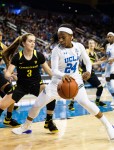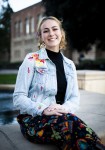Each of the Bruins’ four prior losses to the Ducks were by single digits.
This time, Oregon won a bit more handily.
UCLA women’s basketball (9-8, 2-3 Pac-12) dropped its third straight game Sunday, losing 72-52 to No. 5 Oregon (15-1, 4-0) in a wire-to-wire defeat in front of its largest home crowd of the year. A 21-point third quarter kept the game within reach for the Bruins, but the Ducks put together a 15-2 run in the opening minutes of the fourth to put the game away.
Coach Cori Close said the Bruins’ inefficiency on the defensive glass was the main reason for the lackluster performance.
“Obviously, the challenge that we couldn’t meet was the defensive rebounding,” Close said. “We forced the kind of shots – first-shot misses – that we want, and (then) they got second shot opportunities. It was just too much to overcome.”
Oregon outrebounded UCLA 21-15 on the offensive glass and racked up 25 points on second-chance opportunities. A majority of the Ducks’ offensive rebounds were a result of their 20 attempts from 3-point range.
“A lot of those box outs (led to) long rebounds,” Close said. “Those are not internal rebounds. Those are long, guard rebounds that (the guards) need to get involved (in).”
Oregon – the nation’s fourth-best 3-point shooting team – shot 8-of-20 from beyond the arc. Seven of those 12 misses were corralled by Ducks, and seven of those rebounds led to 14 points.
“I think that’s where our lack of focus came is guard rebounding and the box outs on the outside,” said senior guard Japreece Dean. “I think we just had a lack of focus when we were in zone.”
Two of Oregon’s starters – forwards Ruthy Hebard and Satou Sabally – stand at 6 feet, 4 inches, but UCLA’s tallest starter is 6-feet, 1-inches tall, a mismatch Close said gave the Bruins’ offense fits.
“They’re so long that they can contest and make you think as a shooter, especially as a smaller guard, ‘Can I get this shot off?’” Close said.
The Bruins shot 35 percent from the field and not a single player posted a positive plus-minus.
UCLA’s top two scorers entering the game were sophomore forward Michaela Onyenwere and senior guard Kennedy Burke, but the two combined for 19 points on 24 percent shooting.
Onyenwere said despite the off-night, the Bruins have still elevated their play since the end of November and have taken away important lessons from their matchups against the top teams in the conference this weekend.
“(It was) finding our identity sort of and finding a way to play together,” Onyenwere said. “And I think that we’ve done that since those games and starting the Pac-12. … That just goes to show how much we’ve worked on learning how to fight together. … As we put those things together, I think we can continue to keep doing well in conference.”






